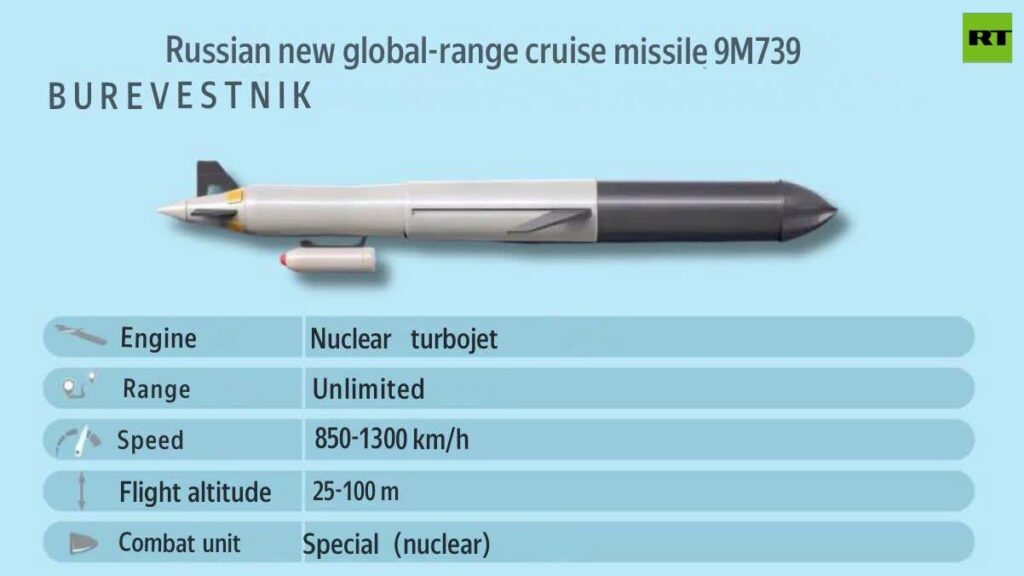Russian President Vladimir Putin on Sunday announced the “successful completion” of tests for the 9M730 Burevestnik, a nuclear-powered cruise missile that Moscow claims can fly indefinitely and evade all known missile defenses — a dramatic display of military ambition that underscores the Kremlin’s intent to reassert nuclear dominance amid the grinding war in Ukraine.
Speaking from a secure military command center, Putin hailed the test as a breakthrough in strategic deterrence, calling the missile “a unique creation that no one else in the world possesses.” The weapon, known to NATO as the SSC-X-9 Skyfall, reportedly flew more than 8,700 miles during a 15-hour test flight on Oct. 21, according to Russia’s Chief of the General Staff Valery Gerasimov. He said the missile’s compact nuclear turbojet engine gives it “virtually unlimited range,” allowing it to remain airborne for weeks and approach targets from unpredictable directions.
“This is about maintaining balance,” Putin said, framing the Burevestnik as a defensive necessity in response to NATO expansion and the United States’ growing missile shield. “The United States is building systems around our borders. We are building guarantees of our security.”
First introduced by Putin in 2018 as part of his so-called “superweapons” initiative, the Burevestnik project has long symbolized Russia’s pursuit of next-generation deterrence. The weapon’s development was marred by serious setbacks — including a 2019 test explosion that killed five nuclear engineers and contaminated an Arctic testing site, earning the missile the grim nickname “Flying Chernobyl.”
But Moscow’s latest announcement, suggesting the weapon is ready for deployment as early as 2027, marks the clearest signal yet that Russia is pressing ahead with advanced nuclear delivery systems. Russian officials say the Burevestnik, roughly 40 feet in length and capable of carrying a megaton-class warhead, can fly at altitudes as low as 30 feet to avoid radar detection.
“The Burevestnik ensures a guaranteed retaliatory strike capability,” Gerasimov told reporters. “Its endurance is unmatched — and the October test wasn’t even its limit.”
The revelation comes as Russian forces step up assaults near Pokrovsk and Kupyansk in eastern Ukraine, reinforcing perceptions that the Kremlin is coupling conventional battlefield gains with nuclear brinkmanship.
The timing also appears calibrated for global effect. With the U.S.-Russia New START treaty set to expire in 2026 and arms control talks stalled, Western officials warned that Moscow’s move could accelerate the collapse of remaining guardrails on nuclear competition.
While the Kremlin hails the test as proof of unmatched technological prowess, analysts remain skeptical of the missile’s practicality — and its safety. “It’s a propaganda win for Putin, but deploying it could invite catastrophe,” said Hans Kristensen, director of the Nuclear Information Project at the Federation of American Scientists.
Nuclear experts note the inherent risks of operating a flying nuclear reactor, from potential radiation leaks to the environmental fallout of an accident. The 2019 explosion already triggered international alarm over the project’s viability.
Still, Putin’s announcement plays well domestically, bolstering a narrative of Russian resilience and innovation under Western sanctions. On Russian social media, users celebrated the missile as proof of Moscow’s ability to “outthink NATO.”
The Burevestnik’s unveiling is the latest signal of a shifting global order. As Russia touts its nuclear “invincibility,” China and North Korea are testing hypersonic glide vehicles, and the U.S. continues modernizing its triad. Arms control frameworks that once constrained such escalation have largely eroded.
Russia, which possesses the world’s largest nuclear arsenal — more than 5,500 warheads — now presents the Burevestnik as both a deterrent and a warning. “Any attempt to undermine our sovereignty or security will face consequences of the highest order,” Putin said.
For the Kremlin, the weapon’s message is as important as its mechanics: Russia remains a superpower that cannot be encircled or ignored. But for the rest of the world, the test revives an all-too-familiar anxiety — that the next generation of deterrence may bring the world closer to catastrophe than control.
(YWN World Headquarters – NYC)











